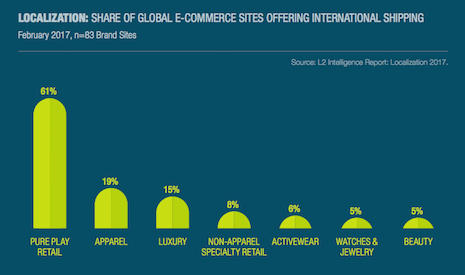Luxury is one of the top three sectors for international ecommerce, and that share is likely to swell as desire for cross-border luxury goods grows.
As more brands offer options for international shipping and local currency purchasing, luxury consumers are beginning to expect a certain level of convenience to cross-border ecommerce. The luxury brands that encourage this expectation and rise to meet it will be most successful.
Buying border free
Luxury brands are very well-suited to take advantage of travel retail, since duty-free stores are the most popular type of retail outlet for Chinese travelers abroad. There can be an ecommerce component to this as well, as a growing number of duty-free retailers across the world are allowing Chinese shoppers to reserve or buy items online and schedule an in-store pickup for when they will be in the country.
One of the most notable consequences of the rise of ecommerce for luxury brands is that online shopping makes porous the borders that separate countries and sometimes kept luxury consumers from accessing their desired brands.
L2 looked at the data behind international ecommerce to determine what brands are doing and what they can improve to make it easier for consumers to shop across borders.
Outside of pure-play online retailers, which understandably make up the bulk of ecommerce transactions and cover a variety of sectors, some of the top sectors for international ecommerce are apparel, jewelry and luxury products.
Since luxury is already such an internationalized sector, it makes sense that it makes up 15 percent of all ecommerce sites that offer international shipping.

Luxury is one of the top three sectors for international ecommerce
But while 15 percent is a respectable number and places luxury in the number three spot for offering international shipping, luxury brands can do more.
Globally, international ecommerce revenue is expected to grow to $900 billion by 2020, representing a huge opportunity for luxury brands who already have a large international audience.
Government policies are already transforming to favor international luxury purchasing.
Foreign accessible luxury and cosmetics brands will benefit from the Chinese government’s current cross-border ecommerce policy, which allows users to purchase online orders of up to 2,000 RMB with no customs duty. Brands selling more expensive items can benefit from significantly faster delivery times when shipping through the cross-border ecommerce zones.
There are also many buyers taking their chances with customs and ordering luxury items from unauthorized individual sellers abroad on a wide range of platforms in order to avoid import tariffs.
International shipping
Some luxury brands have already begun changing their marketing to focus more on international clientele, such as a recent modeling campaign from Net-A-Porter.
In a break from tradition, Net-A-Porter recruited five up-and-coming models of different ethnicities and nationalities for its fall/winter 2016 ad effort which included still imagery and a video component. For its past campaigns, Net-A-Porter worked with a single model to showcase its edit of a season’s must-haves and trend pieces (see story).

Net-A-Porter's international campaign
For luxury brands, investing in international ecommerce is a no-brainer. Luxury brands have consumers from around the world, and with cross-border ecommerce growing from 15 to 22 percent of all ecommerce transactions, it makes perfect sense.
But luxury brands need to be smart about how they tackle that transition. L2 suggests looking at what countries are most amenable to international shopping, such as China, and responding appropriately.
There is strong demand among Chinese consumers to purchase foreign brands through any sales channel where there is going to be a price advantage, including cross-border ecommerce and travel retail.
Luxury brands should adopt coherent global pricing and digital strategies not only for e-commerce, but also when it comes to travel retail by reaching travelers online while they are conducting pre-trip research and offering omnichannel functions such as online item reservation and mobile payment options.
{"ct":"9vSdcRs\/EKEqRV\/TzaK9Q9B8Ri\/w9Tw\/NhlEiaNvkMDN0Qr0Ta83\/H0mFeTF8HyiXahHkc6yxn6uoe5kJRVnS1RQnG03Pjn+g3MWXDMZuE6uJHDuXIP7wMuhECe2RyVZHEgJsua10gTIjZdqStOgDBqp8El0mSm3KseMTnHTOHlDe7PDPsTHikQHCnEtuVmIgQbvPpMsvNEazLmv1Ac2M+S7XHsjmk0Y8BtKj+DzrhMinwbOSE\/CaG4u43Qgb9EgNnV6k9IlIiJf17pXtcMaddwEj4WaAVEfyytxbdPubvSgKW3BpLztlp8GRitlfGQL9uOsASNFik8sgW8S4UyCj3DqPRv4ec3+sJLejkpmSThpFrKcwpWobGsIdhUYxNwMFD62K8M4Zm1FHErQbWU9sB7LDv6KwaGyKWSerE1S1bwhqgfEErpN0jPxK92ETXn1KEOoLOlEimmuwGHmtdw1nhSSFUTAFObNc\/LWTafERDYGVlN3YkJ\/fLKZV6KqQW+w4y3T\/a0\/DjSiqY3NqSOX6l8KA8CuFDSwXNC61aW4dR8k7Mx44\/03aYeNYwPsaOjwWjKnlGl2X4zLc47b+gc05Tuz8v2pqLmF4KTnhLZBzyeG7H4R9G+W4WOo\/NaJ8bwiQ+I1ngBKP0QgRQXfInYmIY10+DkxYoH6w9I0CYF4\/NZZtsy5ikFdVtdYQTcGBFUb3R6ccXsXZydBdS+AUlWxgQTSjf1vBW3JzZNiipiezNAGKywTIX7fceHZyvJGNP6GXl5hYEQ79qZOcjUugCLpxN0K+jG+mS5zqG1e0gkzdK8ZQji1DC+4CBRKGOXfHIsCdzu7u6wXftoNBGpdqJ5EDqXpJXnejhgAaVMay1GYWk7g1Zmqsr2dN9hDvq7cC37lAZRMUci10XCKs9k92OByRuE+D9qpp\/QVpCmM1Vn5B8oetDkWkiH2KDBuuTym1nL8Y7ex7GI2AmrAUftWe4A9EvzrdTVrf1J9EiRUQw\/CN2uZDIDQp4wnBCklbgsuE1+xK0KsGzFvQdhQvCLsUIGTaKf\/HMMNbshSPVtKCeUdMrY4ozjq5aGQZYjCkqkPjN0ed9eqq2uU39JhshCzwMHlwLLhnBdz+CMKjd\/EIcqoFhn6sRVpf7vxvGuNNwO7EqYqaNo1a1ys7sTntqCc6+CDNzhaUXlKKxRfNOPUH\/3Pit31M2UTNmRO9kDAWv8gDwj40OGDIk11ZbxIUj0tDi+9mSKtzFwTLuS9iiZhZVawHjYbRloKcl8gghvSqGy60ZfJZOKoD5TKTrJPTbiBBDEfhWrHFwsV\/0iWri4YYLMMq2FCoOVUfqfduDosCS4PPr8ugoBL0TlzPlmnIOrxZOPDXhJh5l3x9C9ZQd5Vbw7b8sJNML+Z2TuLihItsfNflsulzhKoALi4dyRDZUdfmR5Hkf2wD+fasejLNlG5m2vBEPhmxWzCKoMpj0Urm0o2K2OX2llvCz+v5+az4W\/f2mtx7ywuDoy6HBPGGg5wPxH3w3dlKJdMavInHkYv+TyIXeGQF3fx7KfVF5gTyoQmTzKzle\/wmGW5n7jL13ZnVZ7InWh1QQiHKwqV5g769hKpZCculZ8QvDuKHf6IVzkaym1LtJ\/E1ErFKCnTdyc1jyHVqy0DZxPlesxMVo\/wqRH4s\/A7rcigvBRguQS\/FESFB0ucQM\/TcdAOCgAssKcRiA6NQWL4nXdWrjVq8mr9x70dZLCQMZi3rMHz99krOwyB3wzPAW9Sl6DRe70C34rV6dRljF+dRSUYpJQ0lundVYbfxfWxY4Y9VZ3pMcG5mW7TbzFnIsIWFdTDZJeawAJYm+sLz0K3LW+2Un\/CJmDWpZI4z+v8wi\/McOP0IEpzTDNBJMHKaT2xcvf4awxFFvh2PVI5CM\/79dR8Vanq5RzPyvG8mC8Vjhzqn6wU801nfed6mhso0DJVjSXQejPyE\/vrWJS7bV9PUCPVBslUXB99fiQEDynTJCWvbDXLpyCG9cMn4f+XLLBk\/fj3IWACsXq5vcWUzN4z\/h5u\/xcFMHfwGGy9a8RN6iL\/NqE7f2jmIPdmcvI9NtfF3cvAlsuebXLnwcQk\/sPASuPC\/PVH\/ubaU4X2G1hucliI2FfwDYQohqK9COByhh6yDSKJC7y5+AmC3m2kFShtS0VWMZoVcWxeGXc1CtwqFbS1ZB65F81C9F\/htNQ5X3eJGDH4H8SfYnvwKtDJrzVxZagCvAGFU+ZxqE0n\/W3n9lsrlpu4hBICf7rUxFKJv1e6MufFWB6NlApqEe1cpztb\/yew11iKmGcGbJUK2Jx+5CR\/+TDn4WN5L557oa6PqQCy\/WA90vWeemw4rJolEIzJj0oQ\/nQyfMTeme\/Fpnhk7F5fpXjZxd6R70hpUBKKPhs2aKp6v29upXr5Q6LEVFMolUfcJBekgyS8t4LFrZrTTvKLTd5PiQ+SYi1GKpeoen5P54JbsHOvW3aoaAhZNKYU1Cp6qT1Em7th8+T\/ayLAjhtRvd\/a49fwNrOWFVtz3K7inkI1YwbKmhfFTNN7dpW6urEMcE985chbGdla+2vwnDiaE5M+9xVGwPCB7DM91g5a56bSH\/TQL\/Phds9dAqoK3XMGQYd\/iAhf0NPWy+wL5MfcVf8b0ykiuNlrOXmyDOdyxd20WGwsDZ6ls2oHjEoThj+bs9HcXt95BCRBwULyDCUgfyeaYUecgB7HGnfft5MPcdIInX4nIAEP8YkuxbRFMdWsmz4fA32dYUWP8+4l93ikdbYQxchI2RsBjbmzUYYJ32wEJMheBxUTyt\/PjBx7b6Hlcuj1L0FPrPA+689n0zrRqisnzKKPWVj81U6HJeADaNvcADPppvEVHavfZqKlX8Dg5IdlHNwQr\/C6tgveBve\/8lwup4gUe87f5\/1Li\/8AceNavDfDn\/pPAN3Jwu9JCCrzh6glqUnT9jZ4OY8Stzn6e4wONctp8srPQeVPddiaIAi\/ZWD\/3HQTcTYdSNkHo9VFedSTfT7GpUXUhD9uNM+ybSD0sWWoQqKB5kMivvVBIZxadAWo3uYfpEUw\/G263lGbdNkYUHYQ3mP3\/u+O8WsXLTJyQ\/yW1PhpYNP7dVIIZQ18fDgfzEzFDPPOP9DgZkBFE1iI3EL8ZgoJRb6mp0MFKsJtmFSYbGJL26Oi2OGUttqP0odyzU\/zVWoAShk+GID7zvJ3UrglZQc\/B42o7L+x2gSJY8yuVyBSOXCJQan4VQCMOyIj31nZl5qlBh63SqV93Eaoe\/KfpjZDygm1SWbLkMjf6Skz6YZpTqhnc211DJoQpyPpBxJYZhOqI2I6NM1e+skmbfCz0MIjPRSAetUjeKsjsZfX\/66m73YTzI+IjsjZuYeAlCPv9yRt04F3pl\/CQKs03kBPoivMx6r5mZD3iDzUcwXIFSknYxZDir2Dstm0xPP7AxgUlpQe+An5OZz+8ID4ECESy4iwiERGY0oL2vpLNAjHdLFmkvroKvk\/\/wV\/T8Gz6NC4zQ4VBJ3Us5DjauEAGI1jx+OoH84kN\/n1JdbChIuQmuZcXevkLEHJKD4q0MgcESkQn\/\/MK4miX+0R8yUygpVTUHngpoFMf0yT4rr751CDwFxcj6Yx8XqnBNQiUlOV7NMaeHVVWROTsEv2g\/d71FyEBi3eDfR4efROEHKMG9RF35fElKs8kCQAPw4MgX2CJwhm686VMMSjR4Sp5B+E4ZPe6T4iWPD\/+jWgwnsWCjVg6p4mFLZBxL24uJTTkiaLILo4V3FCwHbOce\/bnM0v8j\/BRuBUXo3OiirFL0mv+wruQMcH4f6X8x\/dANKDduVh2xzFOxnEtgT09crmRFYW56lNB+fTWFWN6yPJI\/uOWBK\/54QIdNBcgUT\/FEdnJIuTPehvAxdtZr1HzYGklOveDniEhGhMAGDcd\/wstuREkP9Mi0ECCdLFowApLZ\/HxNtAQTFZCCH+ozG8zyizBV8Q0LXhBoriNBFgkMHWxEmN6D1NbE1kwXgWBrAUXRI4B4pRYtoBtowa9jE3ZR\/qBdTsDQJ64TpL9HtyoghTr4DbMivZapIb9j8YeEvV\/GlgOiEKcUmbiZfJcXdqexDxKHTmE4kBL2IwKcyWaq4r1vOxfZ2XouKcZuPIMXaez8xEfW9n5fWtIDRUG+7zxp4AIUfh9NXfdP2GC1eRKwB99IDR01oKJd4X49Db7TPHU\/Gs6igDRIQlzc4twdaVtysQZv4nXUbvFotK6oftAXHiqvO87Ck6kFjOrw2e\/YqZeEY01X5o7KzFYTslFxZiKLCOolz8u+38R4qNa9DhVzzH6jPOeYpjnPh9ksqTEs\/feWmCxDVMdzVGTIUntnqJ4km7OxJoXqJjKQGo+A2p\/Ia1YgGKIM8Qe4eDFd2bKNWso6DflKJHjnB1C2xblWR8zTQh9xsDZ6eKMVs+ZbBQrPakhf05+tFbzghcPBMkdbD6Oup\/HLP1MgRigrnQAsDKE5J9+UJmL0BPnqXlDc6B\/fI6pJ58T4+8xrrIaZVVcQAdlPKovFoczXhDk94NP+tGV9NGi+2mXda\/frTSTz8OVV63fZJPYk14a3GVvfnKsSEIiec1J89HzEKd9yASARpWe93QrzzlA8WHLJHYvAFC\/pbP\/PvpjBigGefmkfaRXeW958PjFcY3dB1oHVXZygZ2HP7lkD5cgzS2m2KhuT3XE1Kp\/HcFwFzxeX2cjvPeu+xon2ub87xuCjeXWF83mdBoLvXLQEKQyHV2FfUODbjLofaf4LCpbT677ENKp0HzNrO5wBzeC41NsVbSN6nOyIpBR5oLYRM2r9Tx\/8rjZIFm7Xvh9W1oHRnJWyZrHqzA1HWQUcwWRezy8yCOgo03O9Dm5hh+lnuzMbGLsJ6As9CElxdeVCb1xBE9Qu6Mo+B\/njeOekeqPXxnklbjLNQKJrAnLCCx9h2yxIS8NA5hMEj7Rbjr4rhhsBLUxvUa5qnGD5v\/8PrIQ\/5JM0RMEaimjCkBmOZm2TwE9Dmx51zfwGDLJLTtASWO5CSY5BuzqB3c5i5opLAJq4ah\/\/UD5FuxIUMLeGoan348TmhAVuEjp6Hd+bPymIyCoXgIyTw8PqWSTYVnRuVZH55zCqRGZiUpveFukyVoRtaktpcm0+5s3+st4SM9L0GYWTQoF2GPtrCd5yUijI\/LGYKHG9SQ2LcjA8auswX9i\/77UPcgNclo5AUAzE3OcaeTDUxw1AENJ50osNy\/d91PnYs3+YBTA8I6Q02sxuvSwgs1RoTGdw5fFs1hWYbMsAAbem1PB1O49oSnaMdFsbFKR\/NS02v1XAa4n+CiHEVTIyukxzsDNYkivwI2l+\/5pjSgIcAVjR42H10daoqoa\/OqZ3TAsQ5p0Y\/Kr5WgqxZWA9o0p\/zidjCz4H7GAcs0ATbPvjFMGiaLbRqgWULTRljp4NDAZ2XkupIKLAMWd46nv8+nRVIIkS4ii3fxXPX3qPcjvUXm9kNBBonv5h6MbzHvTfD\/4Y2Ur55CQ8AiZ5pWNgki+yAnNUuwceyN3cLmhHaRuTt9v8bUnKP7fzYUq\/msyBiax+XNgIaSP2gqph4OaukYVmxDg0aJ3qLTTChzX1nauTPJGloJkQa76GsKHCnmfuA96aKxd84+X7Oabn\/KFUOSE2QSemf6fKO9zj7SLw+iDUv0VjOZy6DygEHgizArXkAcNmnEkfuYs5jf5+w2YOhpkTSmkD8Ga4Xsz5+eU5aGNtWaHUTepBiWZ6c5OUQ2kbcrppe4ycKOqwIUjtdBxNLecmq79p9DGUM6Uxeu1DXZX4oooQnMIVN3NgPZyMg8ldyDgSgTWay29JJUQ0x\/iny595VZoKiPjzFkwEp1UeELXQegNJ69IpZ6UquSWpy\/ZriEg3dpyVoxWn6\/vgN3A5YjiwWQ3xFs6B9yn\/woy7zJ73PRh0tkO\/HN8r6srVrh0RTEHys6kYO4S+yBZA8ysSjdcWHfYswUGYbyDeGwqAa\/BgiWPi\/yh7DFKeggzVsPpIJGzYmCxpkFkbRNWXeSG06MZIT602LqknjAAxvQKsg+1Nziq2rngxSD8u9WKI1gSCyZZvGzusJpkyih7efkGl7saU+oteGBg7UDRxstuoun46\/hM7g+s1OKV5Y0Zdv5TM4iK6\/dEaEhPG8EI6WMrzyVsbTPrRIK2RBP60Pj84gXoT9IUlCItO1USTp5JLH6MiLQKIxq+bik1bQ0PvfoRaqOMbIgdxo0xsWwjiZbavs8w9hUxCW2P7RUBmQRAWRP3oK9kfuWsaa2ofyiLOxDgCNu\/qIgjb+oRC\/f7nwtky1puw9zKmuANxkRq8kxJR5dXN3wh6NZEHSFKKpLwdlVvLkYrUHHMzhRB5JrHMO8XEXki2R2BSnsHDltu5oGM\/jrOENH5xFOwoA\/yEyZbqkk7Sa8YmsgkKsyAE4LvHl++Ra8X963F9ek\/5v9qUFIs8II31Z4uy8cAM3LdIQ+qdTSpZbsZS1yv8aDLtdIWWwm5qpqcr1Ye3BEGI9qtDaJL00\/5zfU6flfMt6p7rMR5YYTcPkN7nSz7c59VBy+x5va7raVtMLap34WUvVLmaa\/4Bosq6scYEHyPPshgSS4E79ZmupQrAnfzw\/X5msVDLv504S9Xm2UZlbQeIMY+abEzzO7qjjdgeMZCDrx6VQgFJwkfn4\/cQMDX69sYvYfyzfSZfgughAhVbbFXgqndmOk6gG2K2R0lXXoAVKG9ravS4mHSFxiGDPaZUXcLQmwhZXwslKxLYULLgIjSXPWvLRq1PSStmE5LHJ\/HBxEEf9NZCk8azsAsRsFRCRWO+MpzzG0I7nHKxTsphFpDHa4SLHjFxBXgtGVtvi12SsVca1\/1zaFEhc9t1PMa2at+kKuUGP1gc5ft2eEO2qxIz+CuW6eyYNSAitw21TYFvlC\/3qZwGljaixNFVroWjoTQHP5JAnplRjkleYHIuc0XKTh0uA8Nmf7AKqycPCcYuikWqND9BIsdbBg681naJl+MZ\/9pmdFawto2QAXSpfiFCmdOyxofqGy+tYDTOuPEASE6FdmKON3Gep7n2u+Y\/MvfqhuULPGfGcluB8\/1grOS0vpDjJOV2W6PrzTk6ArohpzEUs\/sxmm9run\/2XyRUfw34yuFK+uQobWayIJjgdGjjiFPQd8llPszrXElu03\/OUNGvxDN6jR+ZIb1O1b6k0v1SJ3iIAYkN0luNmSDOXB78y3QpjbzmmpZIzHxRO0HRSeKSk=","iv":"7c7f306509b917aed48f80aee9603707","s":"5288c684e0b45357"}

 L2's report puts luxury among the top sectors for international ecommrce; Image courtesy of Piaget
L2's report puts luxury among the top sectors for international ecommrce; Image courtesy of Piaget